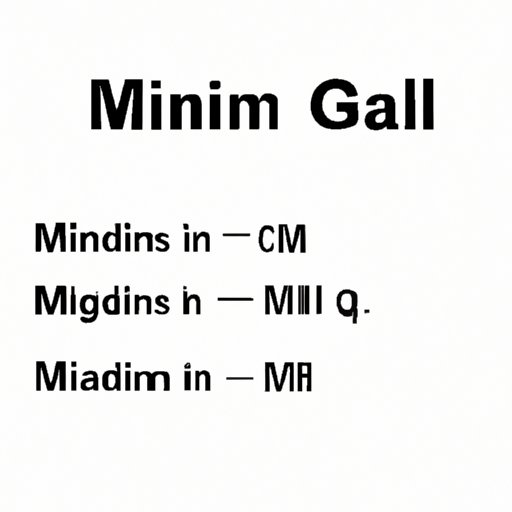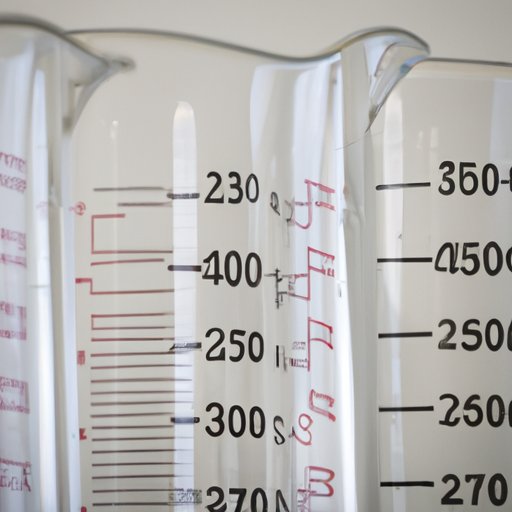Introduction
When it comes to understanding how much of a substance to use in cooking or science experiments, measurements are crucial. Two of the most common units of measurement used are milliliters and grams. However, many people struggle with understanding how many milliliters are in a gram. In this article, we will explore the relationship between these two units and provide a comprehensive guide to converting milliliters to grams.
Understanding the Relationship Between Milliliters and Grams
Milliliters and grams are both units of measurement commonly used in cooking and scientific research. Milliliters measure volume, while grams measure weight. Understanding the relationship between milliliters and grams is important because it allows for accurate and precise measurements in both fields.
Definition of Milliliters and Grams
A milliliter (mL) is a unit of measurement for volume in the metric system. One milliliter is equal to one thousandth of a liter. In other words, a milliliter is a very small amount of liquid.
A gram (g) is a unit of measurement for weight in the metric system. One gram is equal to the weight of one cubic centimeter of water at 4 degrees Celsius.
Importance of Milliliters and Grams in Cooking and Science
In cooking, milliliters and grams are often used to measure ingredients. Accurate measurements are necessary to produce consistent results in the final dish. Too much or too little of an ingredient can impact flavor, texture, and overall quality.
In science, milliliters and grams are used to measure liquids, solids, and other materials. Accurate measurements are important to ensure that experiments are conducted properly and the results are reliable.
How Milliliters and Grams Are Related
The relationship between milliliters and grams is dependent on the density of the substance being measured. Density is the amount of mass per unit volume of a substance.
To determine the number of grams in a milliliter of a substance, you must know its density. This information can be found on the substance’s label or in a reference book.

Converting Milliliters to Grams: A Complete Guide
Converting milliliters to grams can be a daunting task for some. However, with a step-by-step guide, it can be easily accomplished.
Step-by-Step Guide to Converting Milliliters to Grams
To convert milliliters to grams, you will need to know the density of the substance you are measuring. Once you have this information, you can use the following formula:
grams = milliliters x density
For example, if you wanted to convert 50 milliliters of water to grams, you would do the following:
grams = 50 x 1 (the density of water is 1 g/mL)
grams = 50
Therefore, 50 milliliters of water is equal to 50 grams.
Examples and Practical Applications of the Conversion
Converting milliliters to grams can be useful in a variety of practical applications. Here are a few examples:
– Converting milliliters of oil to grams for a baking recipe
– Determining the weight of a liquid medication in milliliters
– Calculating the weight of a chemical in milliliters for a scientific experiment
Common Mistakes to Avoid When Converting Milliliters to Grams
One common mistake when converting milliliters to grams is not using the correct density. It is important to make sure you are using the density of the substance you are measuring.
Another mistake is not paying attention to significant figures. When converting milliliters to grams, make sure to round to the appropriate number of significant figures.
The Science Behind Two Common Units of Measurement: Milliliters and Grams
Understanding the science behind milliliters and grams can help improve your understanding of these units of measurement.
Brief Explanation of the Scientific Principles Behind Milliliters and Grams
Milliliters and grams are both part of the metric system. The metric system is a measurement system based on multiples of ten. It is internationally recognized and used in many scientific fields.
The principles behind milliliters and grams are based on the dimensions of length, mass, and time. These three dimensions form the basis for all measurements in the metric system.
How Milliliters and Grams Are Used in Scientific Research and Experimentation
In scientific research and experimentation, milliliters and grams are used to measure liquids, solids, and other materials. Accurate measurements are essential to ensure that the results of experiments are reliable and valid.
The Importance of Accuracy and Precision in Measuring Milliliters and Grams
Accuracy and precision are critical when measuring milliliters and grams. Accuracy is the measure of how close a measurement is to the true value. Precision is the measure of how close multiple measurements are to each other.
To obtain accurate and precise measurements, it is important to use the correct instruments and techniques.
From Liquid to Solid: How Many Milliliters Equal a Gram
Converting milliliters to grams for liquids and solids can be a bit more challenging because of their different densities.
Explanation of the Different Densities of Liquids and Solids
Liquids and solids have different densities because of the way their molecules are arranged. Molecules in a solid are tightly packed together, while molecules in a liquid are more spread out.
How to Convert Milliliters to Grams for Liquids and Solids
To convert milliliters to grams for liquids, you will need to know the density of the liquid. To convert milliliters to grams for solids, you will need to know both the density of the solid and its volume.
Once you have this information, you can use the formula mentioned earlier:
grams = milliliters x density
Examples of How to Measure Liquids and Solids in Milliliters and Grams
Here are a few examples of how to measure liquids and solids in milliliters and grams:
– To measure 100 milliliters of milk, weigh it to determine the number of grams
– To measure 10 grams of flour, use the density of the flour to determine how many milliliters are needed
Mastering Metric Measurements: Converting Milliliters to Grams
Understanding the metric system can help you master conversions between milliliters and grams.
Overview of the Metric Measurement System and How It Relates to Milliliters and Grams
The metric system is based on multiples of ten. It includes units of measurement for length, volume, mass, and temperature. Milliliters and grams are both part of the metric system and are used to measure volume and weight, respectively.
How to Convert Other Metric Units to Milliliters and Grams
To convert other metric units to milliliters and grams, you will need to know the appropriate conversion factors. For example, to convert centimeters to millimeters, you would multiply the number of centimeters by 10.
Examples of How to Use Metric Measurements in Recipes and Other Applications
Here are a few examples of how to use metric measurements in recipes and other applications:
– To measure 250 grams of sugar, use a digital scale
– To measure 500 milliliters of water, use a liquid measuring cup
How to Easily Convert Milliliters to Grams in Your Kitchen
Converting milliliters to grams in a kitchen setting can be simplified with a few tips and tricks.
Practical Tips and Tricks for Converting Milliliters to Grams in a Kitchen Setting
– Use a digital scale for accurate measurements
– Make sure to use the appropriate density for the ingredient being measured
– Keep a conversion chart handy for quick reference
Common Kitchen Tools for Measuring Milliliters and Grams
Common kitchen tools for measuring milliliters and grams include:
– Digital scale
– Liquid measuring cup
– Measuring spoons
Recipes That Use Milliliters and Grams as Units of Measurement
Many recipes use milliliters and grams as units of measurement. Here are a few examples:
– French macarons
– Lemon pound cake
– Spaghetti carbonara
Breaking Down the Myth: How to Calculate Milliliters to Grams Like a Pro
There are many myths and misconceptions surrounding converting milliliters to grams. Here, we debunk common misunderstandings and provide expert advice on calculating milliliters to grams accurately and efficiently.
Addressing Common Misconceptions and Myths About Converting Milliliters to Grams
One common myth is that all liquids have the same density. This is not true, as the density of a liquid is dependent on its composition.
Another misconception is that grams and milliliters are interchangeable. This is not the case, as grams measure weight and milliliters measure volume.
Expert Advice on How to Calculate Milliliters to Grams Accurately and Efficiently
To calculate milliliters to grams accurately and efficiently, always use the appropriate density and instruments for measuring. Refer to conversion charts or utilize online conversion tools for quick and easy reference.
Additional Resources for Learning More About Milliliters, Grams, and Metric Measurements
There are many resources available online and in books for learning more about milliliters, grams, and metric measurements. A few recommended resources include:
– Metric Conversions website
– “The Metric System Made Simple” by Albert F. Kempf Jr.
– “Metric Pattern Cutting for Women’s Wear” by Winifred Aldrich
Conclusion
In conclusion, understanding how many milliliters are in a gram is important for accurate and precise measurements in cooking and scientific research. By understanding the science behind these two units of measurement and mastering metric conversions, you can easily convert milliliters to grams. Use the resources and tips provided in this article to improve your understanding of milliliters and grams and improve your measurement-taking skills.
